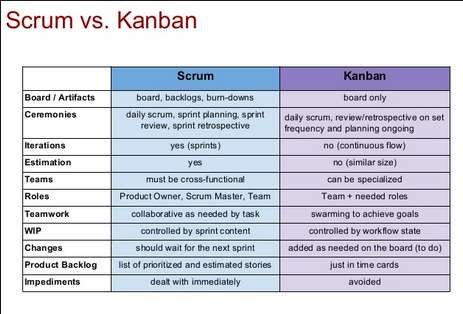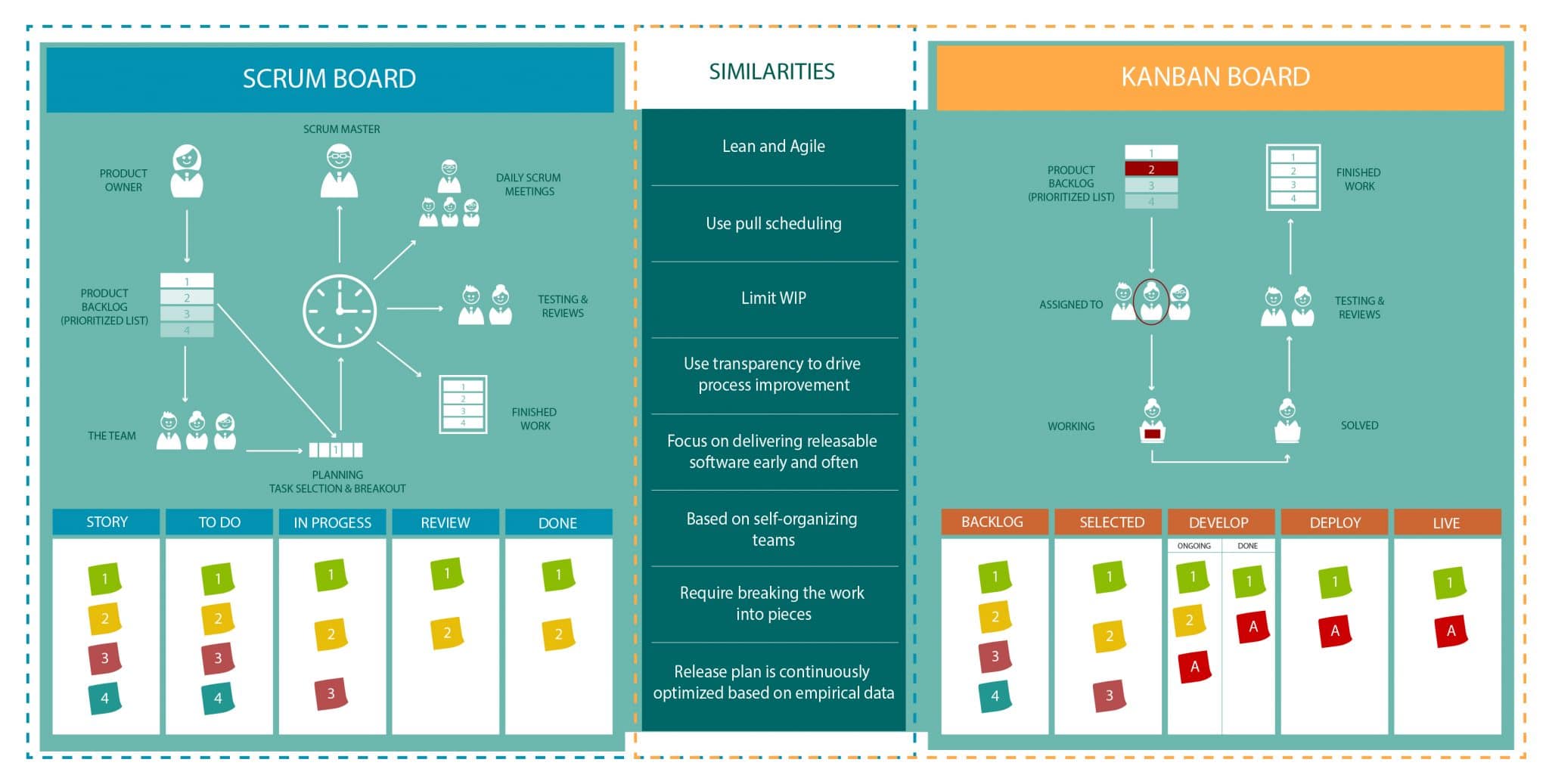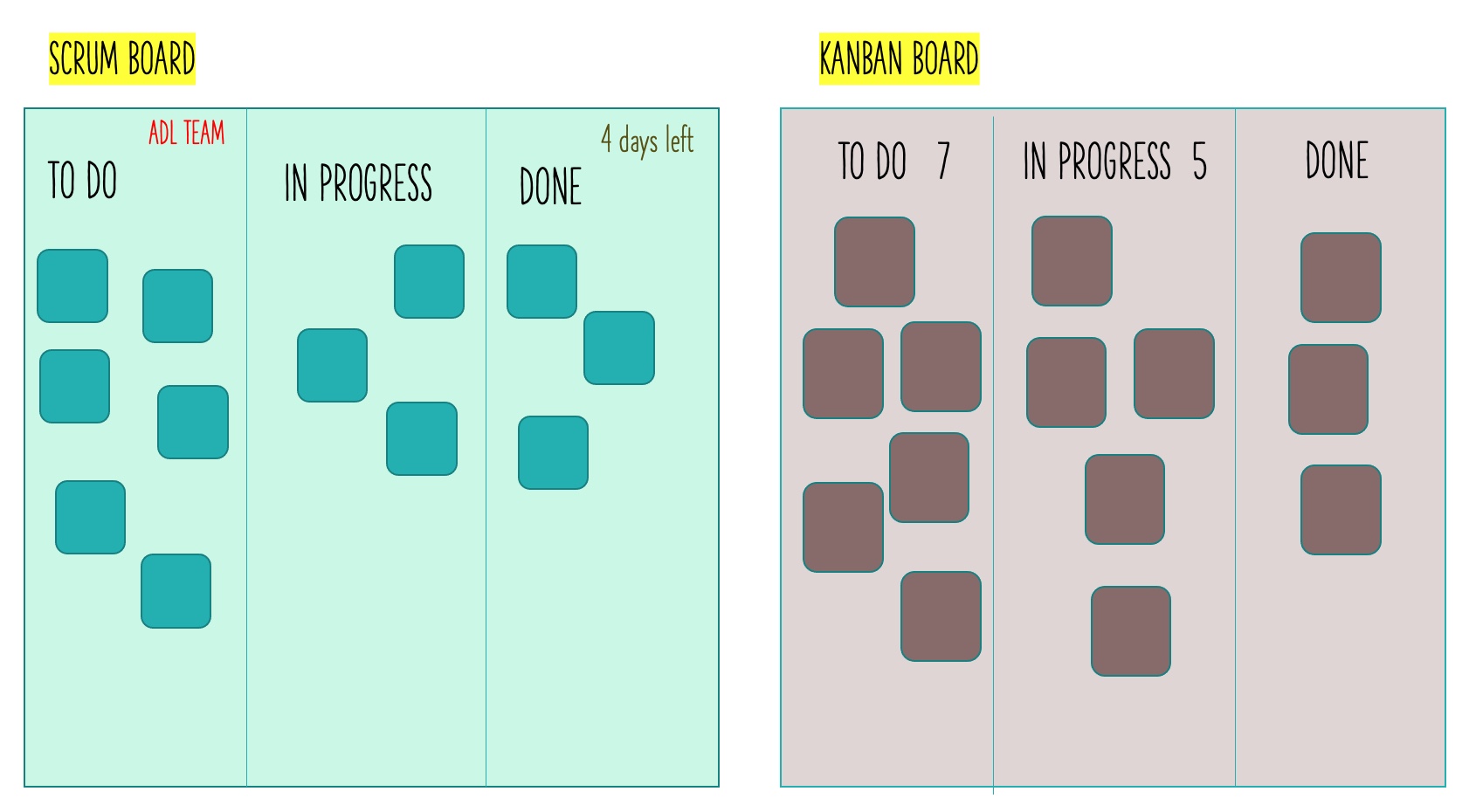Agile Project Management: An Overview
Agile project management is a methodology centered around continuous improvement, collaboration, and flexibility. It emphasizes close collaboration between the development team and stakeholders, iterative progress, and rapid adaptation to change. Scrum and Kanban are two popular Agile methodologies that use visual tools, known as Scrum boards and Kanban boards, to manage workflow and track progress.
Scrum Board: A Tool for Time-Boxed Iterations
Scrum boards are visual tools designed to manage time-boxed iterations called sprints, which typically last 1-4 weeks. These boards help Scrum teams break down work into manageable tasks and track progress throughout the sprint. By visualizing the workflow, Scrum boards foster transparency, collaboration, and continuous improvement. In a Scrum board, tasks are usually represented as sticky notes or cards, and they move across columns representing different stages of the workflow, such as To Do, In Progress, and Done. By limiting the number of tasks in the In Progress column, teams can focus on completing work instead of starting new tasks, reducing work-in-progress (WIP) and increasing productivity.
How to Implement a Scrum Board
To implement a Scrum board, follow these steps:
- Create columns for To Do, In Progress, and Done. You can add additional columns if needed, such as Review or Testing.
- Write tasks on sticky notes or cards, ensuring each task is small, specific, and actionable. Limit each task to a single action to promote clear understanding and easy tracking.
- Place all tasks in the To Do column at the beginning of the sprint.
- During the sprint, move tasks from To Do to In Progress when team members start working on them. Limit the number of tasks in the In Progress column to avoid overloading the team.
- Once a task is completed, move it to the Done column. This action provides a visual representation of progress and motivates the team.
- Regularly review the Scrum board during daily stand-up meetings to discuss progress, address any issues, and plan next steps.
By implementing a Scrum board, teams can better manage their workload, improve communication, and increase productivity.
Kanban Board: A Flexible Approach to Workflow Management
Kanban boards are visual tools designed to manage workflow and limit work in progress. Unlike Scrum boards, Kanban boards do not rely on time-boxed iterations. Instead, they focus on continuous delivery and flexibility, making them an excellent choice for projects with evolving requirements.
In a Kanban board, tasks are represented as cards, and they move across columns representing different stages of the workflow. By limiting the number of tasks in each column, teams can focus on completing work instead of starting new tasks, reducing work-in-progress (WIP) and increasing productivity.
How to Implement a Kanban Board
To implement a Kanban board, follow these steps:
- Create columns representing the various stages of your workflow. Common columns include Request, In Progress, and Done. Customize the columns to fit your team’s unique needs.
- Write tasks on sticky notes or cards, ensuring each task is small, specific, and actionable. Limit each task to a single action to promote clear understanding and easy tracking.
- Place all tasks in the Request column at the beginning. This column represents the backlog of work waiting to be started.
- During the project, move tasks from Request to In Progress when team members start working on them. Limit the number of tasks in the In Progress column to avoid overloading the team.
- Once a task is completed, move it to the Done column. This action provides a visual representation of progress and motivates the team.
- Regularly review the Kanban board during stand-up meetings to discuss progress, address any issues, and plan next steps.
By implementing a Kanban board, teams can better manage their workload, improve communication, and increase productivity.
Scrum Board vs. Kanban Board: Key Differences
Scrum boards and Kanban boards are both powerful visual tools for project management, but they approach workflow management and time management differently. Understanding these differences can help teams choose the right tool for their needs.
- Time Management: Scrum boards focus on time-boxed iterations called sprints, typically lasting 1-4 weeks. This structure helps teams plan and execute work in a consistent, predictable manner. In contrast, Kanban boards do not rely on fixed iterations, allowing for more flexibility in managing workflow and accommodating changes as needed.
- Workflow Management: Scrum boards break down work into manageable tasks within sprints, while Kanban boards visualize the entire workflow from start to finish. This difference makes Scrum boards more suitable for projects with well-defined user stories and time constraints, while Kanban boards excel in projects requiring high flexibility and continuous delivery.
- Flexibility: Kanban boards offer greater flexibility in managing workflow, as they can accommodate changes without disrupting the overall workflow. Scrum boards, on the other hand, follow a more structured approach with less flexibility, as they are tied to time-boxed sprints.
Ultimately, the choice between a Scrum board and a Kanban board depends on the team’s needs and the nature of the project. Both tools have their strengths and can be valuable visual aids for project management in Agile environments.
When to Use a Scrum Board vs. a Kanban Board
Choosing the right visual tool for project management depends on the team’s needs and the nature of the project. Here are some scenarios where each tool is more appropriate:
- Scrum Board:
- Projects with fixed iterations: Scrum boards are ideal for projects with time-boxed sprints, allowing teams to plan and execute work in a consistent, predictable manner.
- Well-defined user stories: Scrum boards work well when user stories and tasks are clearly defined, enabling teams to break down work into manageable chunks.
- Regular reviews and retrospectives: Scrum boards facilitate regular reviews and retrospectives, helping teams continuously improve their processes and identify areas for improvement.
- Kanban Board:
- Highly flexible projects: Kanban boards are perfect for projects requiring high flexibility, as they can accommodate changes without disrupting the overall workflow.
- Continuous delivery: Kanban boards excel in projects where continuous delivery is essential, as they do not rely on fixed iterations and allow for a smooth, steady flow of work.
- Managing workflow: Kanban boards provide a comprehensive view of the entire workflow, making them suitable for teams looking to optimize their processes and visualize bottlenecks.
By understanding the strengths and weaknesses of both Scrum boards and Kanban boards, teams can make informed decisions about which visual tool best supports their project management needs.
Combining Scrum and Kanban: Scrumban
Scrumban is a hybrid approach that combines the best of both Scrum and Kanban, allowing teams to balance the need for structure and flexibility. By incorporating elements from both methodologies, Scrumban can help teams optimize their workflow and continuously improve their processes.
- Structure of Scrum: Scrumban retains the structure of Scrum, including time-boxed iterations (sprints) and regular meetings (daily stand-ups, sprint planning, sprint review, and sprint retrospective). This structure helps teams maintain focus, plan work, and track progress.
- Flexibility of Kanban: Scrumban adopts the flexibility of Kanban, particularly the visualization of workflow and the limitation of work in progress. By visualizing the entire workflow and limiting the number of tasks in progress, teams can identify bottlenecks, optimize their processes, and increase productivity.
Implementing Scrumban involves setting up a Scrumban board, which combines elements of both Scrum and Kanban boards. A Scrumban board typically includes columns for Request, In Progress, and Done, as well as additional columns for To Do and Review, depending on the team’s needs. By using a Scrumban board, teams can enjoy the benefits of both Scrum and Kanban while addressing the unique challenges of their projects.







